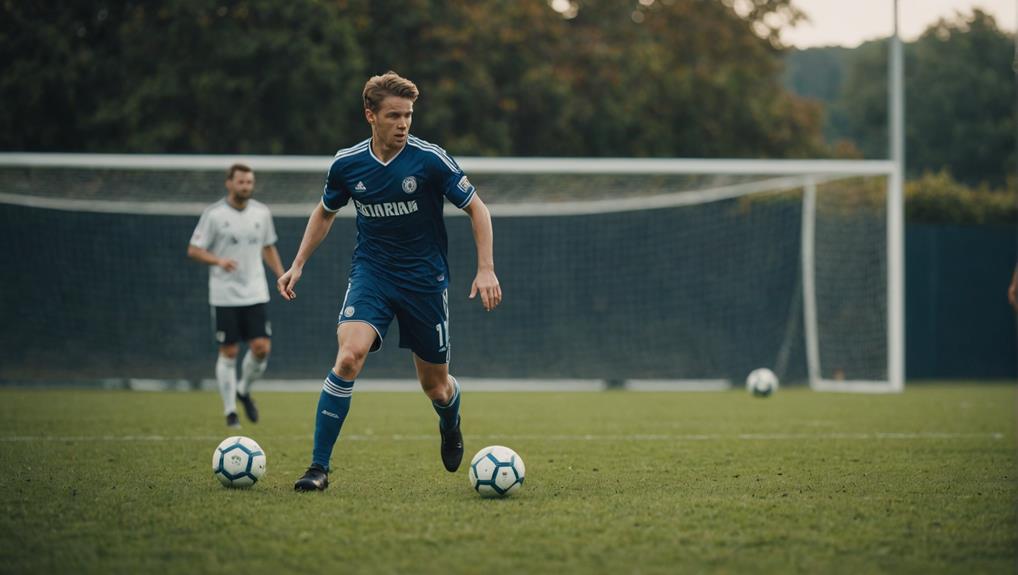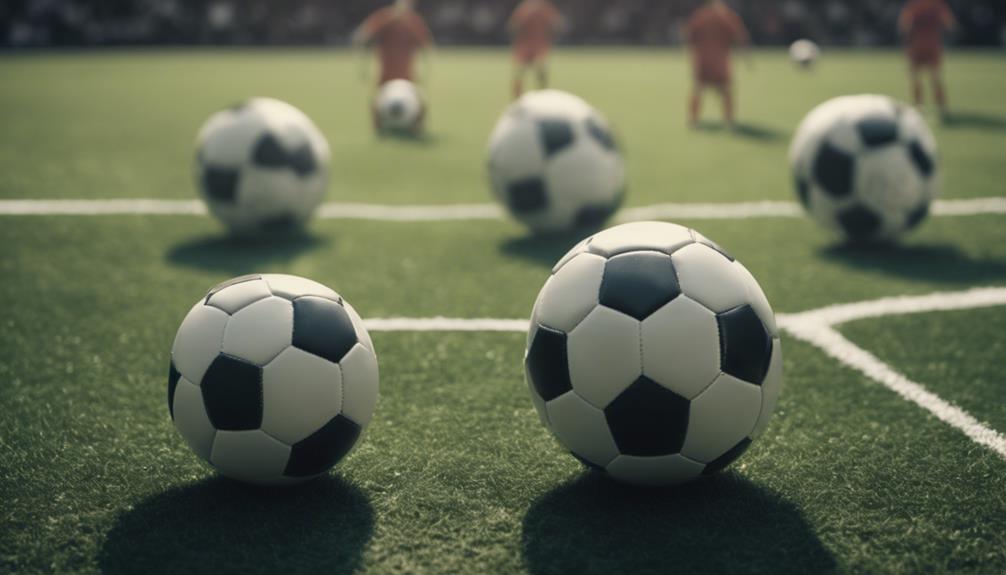
How to Play Football Soccer: A Beginner’s Guide
August 13, 2024Ready to kickstart your soccer journey? In football soccer, two teams battle on a rectangular field, with only goalies allowed to use their hands. Referees enforce rules, leading to free kicks and cards. Games have two 45-minute halves. Dribbling and passing are key skills, while defenders, midfielders, forwards, and sweepers play distinct roles. Proper equipment, like shin guards and cleats, ensures safety. Strategic positioning and effective communication with teammates are crucial. Get ready to step onto the field and embrace the excitement of soccer – the ultimate team sport where skill meets strategy for an unforgettable experience.
Basic Rules of Soccer
To understand the game of soccer better, familiarize yourself with the basic rules that govern how the sport is played. Soccer is a game where two teams of 11 players each compete to score more goals than their opponents. The match takes place on a rectangular field with specific dimensions, and players aren't allowed to use their hands except for the designated goalkeeper. Referees enforce the rules and call fouls for violations, which can result in penalties like free kicks, yellow cards, or red cards.
Moreover, understanding set pieces such as throw-ins, corner kicks, and goal kicks are essential for restarting play and creating scoring opportunities.
As a beginner, grasping the basic rules of soccer like offside, fouls, and misconduct is vital for enjoying and actively participating in the game. By following these fundamental rules, you can enhance your overall soccer experience and contribute effectively to your team's success.
Essential Soccer Skills
To excel in soccer, you must master essential skills like dribbling techniques, passing fundamentals, and defensive strategies.
Dribbling helps you maneuver past opponents with precise touches, while passing accurately is key to setting up scoring chances for your team.
Understanding defensive strategies will enable you to maintain a strong defensive line and prevent your opponents from scoring.
Dribbling Techniques
Mastering dribbling techniques is vital for any soccer player looking to excel on the field. Dribbling involves using precise touches to control the ball while maneuvering past defenders.
Players rely on the inside and outside of their feet to dribble effectively, allowing them to change direction swiftly and evade opponents with ease.
Developing strong dribbling skills demands dedication to practice, agility, and a keen awareness of the players around you. By honing your dribbling abilities, you can create scoring opportunities for your team and maintain possession during pivotal moments in the game.
A skilled dribbler has the capacity to deceive opponents, open up space on the field, and efficiently advance the ball towards the goal. Remember, mastering dribbling techniques not only enhances your individual performance but also contributes significantly to your team's success on the soccer field.
Passing Fundamentals
Developing your passing fundamentals in soccer is vital to creating scoring opportunities and maintaining possession on the field. Mastering passing skills such as using the inside of the foot, instep, and outside of the foot is essential for effective ball distribution during a game. To excel in passing, focus on accuracy, timing, and the weight of your pass.
Understanding angles, body positioning, and communicating with teammates are crucial aspects of successful passing in soccer.
Incorporate different types of passes like short, long, and through passes to advance the ball strategically and challenge the opponent's defense. By practicing and honing your passing abilities, you'll be able to contribute significantly to your team's gameplay.
Defensive Strategies
Understanding defensive strategies in soccer is important for maintaining a strong defense and effectively protecting your team's goal.
Defensive strategies involve proper positioning to intercept passes and block shots. To excel in defense, communication with teammates is crucial to mark opponents and defend as a unit.
Defenders must focus on closing down space, pressuring the ball carrier, and forcing turnovers to regain possession. Additionally, grasping the offside rule is necessary for defenders to prevent opponents from gaining an advantage by staying behind the last defender when the ball is played.
Mastering defensive skills such as tackling, jockeying, and heading can greatly enhance a defender's performance on the field. By implementing these defensive strategies, you can contribute to a solid defense that frustrates the opposition and provides a strong foundation for your team's success.
Soccer Positions Explained

To understand the roles of players on the soccer field, it's important to grasp the different positions and their specific functions. Defenders play a vital role in stopping the opposition's attacks, marking opposing players, and clearing the ball to protect the goal.
Midfielders act as the link between defense and offense, controlling the game's flow, distributing passes, and providing support on both ends of the field.
Forwards are tasked with scoring goals, creating opportunities, and pressuring the opposing defense. Additionally, the sweeper, positioned behind the main defenders, acts as the last line of defense, providing cover, sweeping up loose balls, and supporting the backline.
Understanding these positions is necessary to forming a cohesive team that can effectively execute strategies on the field. Each player must fulfill their role to guarantee the team operates smoothly and efficiently during matches.
Understanding Game Structure
Soccer matches are structured into two 45-minute halves with added stoppage time for delays and injuries. The game follows the Laws of the Game, which dictate the rules and player conduct. It concludes when the referee blows the final whistle after both halves and stoppage time.
Substitutions play an essential role in the game, allowing teams to replace players within the specified limits set by competition rules. Understanding the game's duration, stoppage time, and substitution regulations is crucial for both players and fans to grasp the flow and dynamics of a match.
Soccer Equipment Essentials

As you gear up to step onto the soccer field, make sure you have the essential equipment to play the game effectively.
Start by ensuring you have your shin guards on. These guards are vital for preventing injuries during tackles and kicks.
Then, lace up your cleats. Cleats provide the necessary traction on the field, allowing you to make quick movements without slipping.
For goalkeepers, don't forget to pack your gloves. These specialized gloves not only improve your grip on the ball but also offer protection for your hands during dives and saves.
Remember, whether you're a field player or a goalkeeper, wearing properly fitting equipment is essential.
A well-fitted jersey or kit, shorts, and socks complete your soccer attire, ensuring you're comfortable and safe during gameplay.
Joining a Soccer Team
Considering joining a soccer team?
One of the best ways to immerse yourself in the game and enhance your skills is by joining a local soccer team or club. These teams provide regular training sessions and matches that can help you grow as a player.
If you're looking for a more competitive experience, consider attending tryouts for teams that participate in higher levels of competition. On the other hand, if you prefer a more laid-back approach, recreational leagues in your area offer a casual and social environment suitable for all skill levels.
Additionally, if playing isn't your main focus but you still want to be involved in soccer, you can explore coaching or refereeing opportunities within the soccer community. Another option is to connect with fellow players through social media or community events to form your own team and enjoy the game together.
Joining a soccer team not only improves your skills but also allows you to be part of a community that shares your passion for the sport.
Mastering Game Strategies

To master game strategies in soccer, focus on strategic positioning tips that can give you an edge on the field.
Effective team communication is vital in coordinating plays and maximizing scoring opportunities.
Strategic Positioning Tips
Understanding strategic placement is necessary for mastering game strategies in football soccer, allowing players to anticipate plays and make effective decisions on the field.
Defensive placement is essential for blocking passing lanes, applying pressure on opponents, and maintaining a compact defensive shape. By mastering defensive placement, you can disrupt the opponent's attacking flow and create turnovers to regain possession.
On the other hand, offensive placement is crucial for creating scoring opportunities, supporting teammates, and exploiting gaps in the opponent's defense. Effective offensive placement enables you to find spaces to receive passes, make runs behind the defense, and contribute to goal-scoring chances.
Developing positional awareness is key to seamlessly shifting between defensive and offensive roles as the game progresses.
Effective Team Communication
Mastering game strategies in football soccer hinges on fostering effective team communication through clear verbal cues and strategic non-verbal interactions between players. In soccer, team communication is the cornerstone of successful gameplay.
Verbal cues play a crucial role in coordinating movements and tactics on the field. Whether it's calling out for a pass or signaling a specific play, concise communication keeps everyone on the same page.
Additionally, non-verbal communication, such as gestures, eye contact, and positioning, is equally essential for seamless teamwork. Understanding your teammates' tendencies and playing styles enhances communication, enabling you to anticipate their actions and make split-second decisions.
During set pieces like corner kicks and free kicks, quick and accurate communication can create scoring opportunities. Developing a system of signals and calls for different situations further improves team communication and overall performance.
Positive Reviews and Feedback
Readers have praised the beginner's guide to soccer for its informative and easy-to-understand content. Parents have especially appreciated how the book has helped their children learn and enjoy playing soccer. The positive feedback highlights the extensive nature of the guide, with clear explanations provided throughout.
Reviewers have consistently mentioned that the book serves as a great resource for beginners looking to grasp the basics of soccer effectively. Many readers have expressed their enjoyment of the book, emphasizing how it has helped them build a solid foundation in understanding the sport.
Conclusion
Congratulations, you're now a soccer pro! With these basic rules, skills, positions, and strategies under your belt, you're ready to dominate the field.
So grab your gear, lace up those cleats, and get ready to score some goals like never before.
Remember, practice makes perfect, so keep honing your skills and soon enough, you'll be unstoppable on the soccer field.
Go out there and show the world what you're made of!


